|
All
About / Live stock
Save
the Dairy sector-Save Rs. 1043 Billion per anum
M.Subhan Qureshi, PhD
THE ISSUE
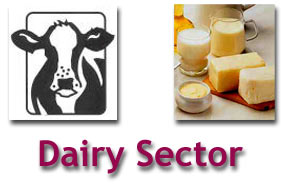 Utilization of science as a tool for development of economies of
nations, has divided the world into two components, the developing
and the developed world. The formers have ignored their natural
resources while the laters have exploited them upto maximum
capacity. Resultantly, the developing countries have got an
opportunity of utilizing the potential of their natural resources.
Mostly, this process does not need use of very advanced technologies
as improvement in management of resources would result in a an
increase in the profit by manifold. Utilization of science as a tool for development of economies of
nations, has divided the world into two components, the developing
and the developed world. The formers have ignored their natural
resources while the laters have exploited them upto maximum
capacity. Resultantly, the developing countries have got an
opportunity of utilizing the potential of their natural resources.
Mostly, this process does not need use of very advanced technologies
as improvement in management of resources would result in a an
increase in the profit by manifold.
However, for sustainable
enhancement of productivity and products processing and management,
high-tech research is the key factor to support such enterprises.
Thus, the developing countries must look towards science for their
economic revival.
According to a research study (Qureshi et al. 2002; Asian-Aust.
J.Anim.Sci. Korea, 330-339.), in the in the Indo-Pakistan
sub-continent, buffalo dairy farming is practiced on non-scientific
lines and there is no tradition of consulting animal health,
reproduction or nutritional experts in identifying or addressing the
relevant problems. The socio-economic status of the peri-urban dairy
farmers is usually low, getting negligible inputs from livestock,
financial or marketing institutions or experts. The major causes
associated with the under-developed buffalo farms have been
identified as:
i) calf losses, irregular breeding, imbalanced feeding;
ii) ungainly loans and;
iii) a hostile marketing system. The three causes at commercial
buffalo herds throughout Pakistan, lead to annual losses to the tune
of Rs.1043.67 billions (US$ 1 = Rs.60).
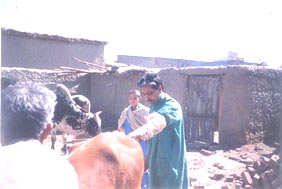 The peri-urban dairy farmers are rarely interested in rebreeding of
their cattle. If interested, they use natural service for breeding
and have no concept of special care for propagation of their high
performance animals and culling the poor ones. Use of artificial
insemination for genetic improvement is almost non-existing. The peri-urban dairy farmers are rarely interested in rebreeding of
their cattle. If interested, they use natural service for breeding
and have no concept of special care for propagation of their high
performance animals and culling the poor ones. Use of artificial
insemination for genetic improvement is almost non-existing.
Calf rearing is considered expensive and frequently avoided due to
higher prices of milk, around Rs.20 per kg. Most of the farmers sell
their calves within the fast month, to butchers. In the remaining
calves, the unhygienic and unscientific rearing arrangements are
associated with higher calf mortality due to under- or over-feeding
of milk or infestation with external or internal parasites. Only 84%
of calves remain alive beyond 150 days postpartum.
The existing feeding strategy at the peri-urban buffalo dairy farms
is not based on requirement of the animals, composition of the feed
ingredients or expert consultation. Animals are fed at the same
scale irrespective of their milk production. The high yielding
buffaloes remain under-fed while the low yielders are adversely
effected by excess intake of protein. Nili-Ravi buffaloes show a
seasonal pattern in breeding, associated with higher intake of
metabolizable energy, zinc and calcium and lower intake of crude
protein, magnesium, phosphorus and copper.
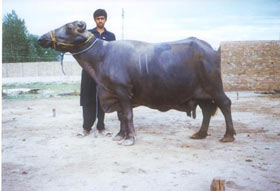 Under the present farming system, the dairy farmers are discouraged
because of the poor marketing system. Prices of livestock inputs are
under free market, increasing with a linear upwards trend but those
of livestock outputs i.e. milk and meat are under
government control, not fixed according to production cost. Milk
marketing is in the hands of middlemen, whose approach towards
farmers and milk consumers is apathetic and whose only goal is to
make maximum money through minimum efforts, in a minimum time
period. Under the present farming system, the dairy farmers are discouraged
because of the poor marketing system. Prices of livestock inputs are
under free market, increasing with a linear upwards trend but those
of livestock outputs i.e. milk and meat are under
government control, not fixed according to production cost. Milk
marketing is in the hands of middlemen, whose approach towards
farmers and milk consumers is apathetic and whose only goal is to
make maximum money through minimum efforts, in a minimum time
period.
Livestock feeds, medicines, etc., are also in the hands of traders
having little interest in livestock development. Animals, without
having any health, production or reproduction record, are purchased
by dealers and provided to the dairy farms on interest
rates usually higher than 60% per annum. The farmers get loans from
milk dealers with undesirable terms and conditions. Only about 2% of
the milk produced in the country gets access to a processing and
marketing channel while in India 40% of milk produced is
processed and marketed.
The existing marketing activities result in a low return to the
livestock farmers, putting him under severe financial pressure,
forcing him to either abandon the livestock keeping business or
squeeze it to a minimum size. Dealers of dairy animals, feed and
milk earn 50 to 100% profit from the farms, for low quality services
and investment of their money for a small period of less than an
year. Dairy farmers, mostly of low socio-economic status, have
little knowledge about banks and other loaning agencies, to
successfully operate their enterprises.
Our neighbor (India) solved the problem through systematic and
sustainable efforts. Village milk producers cooperatives societies (VMPCS)
were established in India in 1946 at Anand and during 1996, managed
0.54 million farmers, 0.63 million liters milk/day and Rs.3803
million sale per anum.
Administration of this model comprised a 3 tier structure namely,
VMPS (Village) Union (districts.) Federation (Apex). Secretary
Agriculture, Government of India gave a policy statement "To foster
and promote dairy development on cooperative line". The
tool used was Operation flood (OF). The idea was conceived by Shri
Lal Bahadur Shastri Prime Minister, who suggested the National Dairy
Development Board to create Anand pattern dairy cooperative (APDC).
The driver used was "Indian Dairy Corporation" as a
"Finance and Promotion House". The story led to execution of OF-I
---> OF-II ---> OF-III.
THE SOLUTION
To prevent the losses mentioned above, a "Dairy Development Network
Plan" has been prepared which handles these problems through an
integrated approach. Salient features of the plan are as given in
the following paragraphs.
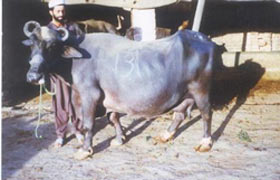 A. Financial Support Network A. Financial Support Network
The project will establish a Financial Support Network comprising
allocation in the federal and provincial development programs,
micro-credit and SME banks and Zakat Fund, etc. Due share in the
foreign grants will be allocated for the purpose. A one-time
endowment fund will be established for initiating sustainable
commercial activities. The funds will be used for disbursement of
loans to the farmers for establishing or expanding dairy farms or
calf rearing centers. Loans will also be extended to veterinarians,
veterinary assistants and artificial insemination assistants/
technicians for initiating or improving their professional
activities. Technicians interested in chilling plants or milk/meat
processing units will be provided loans. These loans will be
extended on profit and loss sharing or interest-free basis.
DDN revolving fund (DDN-RF) will be generated through receipts
within DDN and used for DDN operations. Commercial dairy herds will
be registered by the DDN, they will be provided financial, marketing
and technical support and they will be regulated for
producing products according to WTO standards.
B. Marketing Support Network
A Marketing Support Network will be established for meeting the
needs of dairy farms regarding inputs and products. Livestock
Utility Stores (LUS) will be established for providing high quality
cheaper feeds, milk replacers, medicines, hormones, growth
promoters,
semen, milk registers, cow cards, etc. for use at the farms.
 High
quality farm equipment needed for the farm e.g. buckets, milk
containers, grass cutters, spray pumps, calf feeders, etc., will be
made available at the LUSs. The farmers will be assisted in
purchasing elite animals for their farms. Production of semen, feeds
and other farm inputs will be initiated on commercial basis. Elite
animals at the farms will be registered and monitored for their
performance and rebred at the earliest or advertised for sale, if
needed. Milk chilling facilities will be established at proper
places and linked with the dairy farms and milk plants or sale
points for disposal. Culling will be a regular feature at the dairy
farms and the culled animals will be purchased for (fattening if
needed
and) slaughter. High
quality farm equipment needed for the farm e.g. buckets, milk
containers, grass cutters, spray pumps, calf feeders, etc., will be
made available at the LUSs. The farmers will be assisted in
purchasing elite animals for their farms. Production of semen, feeds
and other farm inputs will be initiated on commercial basis. Elite
animals at the farms will be registered and monitored for their
performance and rebred at the earliest or advertised for sale, if
needed. Milk chilling facilities will be established at proper
places and linked with the dairy farms and milk plants or sale
points for disposal. Culling will be a regular feature at the dairy
farms and the culled animals will be purchased for (fattening if
needed
and) slaughter.
C. Technical Service
Livestock farmers (cattle and buffaloes >5 heads per farmer) will be
registered and record will be maintained in respect of health,
production and marketing. This record will be used for
identification of valuable animals and selection of males and
females
for further breeding, vaccination, deworming and culling. Stationary
will be purchased by the farmers themselves.
The registered animals will be vaccinated against major infectious
diseases, at nominal charges. Arrangement of emergency services to
registered farmers will be made. Emergency visits will be charged
per visit of doctor plus services and medicines
charges. Charges so made will be shared by the practitioner and the
project. Mastitis and brucellosis control program will be initiated
at registered herds at a minimum possible rate. Farmers will be
educated properly, in this regard.
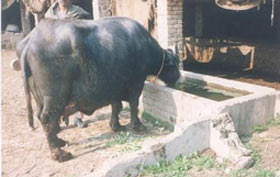 Selective breeding will be made through intensive propagation of
superior animals and culling of inferior ones from the registered
herds. Animals having productive and reproductive levels of 1 SD
above mean will be selected for rebreeding ('A' class)
and those have 1 SD below mean ('B' class), will be culled. Those
having 2 SD above mean ('AA' class) will
be selected for intensive propagation. Efforts will be made to
procure semen from proven sires from SPU Qadirabad or elsewhere and
will be used in the buffalo cows with higher performance. Fertility
control program will be initiated in the project animals. Selective breeding will be made through intensive propagation of
superior animals and culling of inferior ones from the registered
herds. Animals having productive and reproductive levels of 1 SD
above mean will be selected for rebreeding ('A' class)
and those have 1 SD below mean ('B' class), will be culled. Those
having 2 SD above mean ('AA' class) will
be selected for intensive propagation. Efforts will be made to
procure semen from proven sires from SPU Qadirabad or elsewhere and
will be used in the buffalo cows with higher performance. Fertility
control program will be initiated in the project animals.
Farmers will be educated about heat detection regimes and breeding
at proper time, curtailing losses due to postpartum anestrus and
delayed breeding. Infertility will be treated properly.
To decrease the cost of rearing of calves, arrangement of milk
replacer for calf rearing will be made, on minimum possible rate, on
cash. Calves from dams of better performance will be reared and
those from poor performance will be fattened and slaughtered.
Farmers not willing to rear their calves will be approached to sell
them to the project, who will keep them, monitor
their growth and other parameters and use them for production of
sires, dams or meat.
Higher yielding fodder varieties will be introduced. Computation of
feed based on locally available ingredients (oil-seed cakes, dry
roughage, non-conventional feeds, etc.) will be introduced. Supply
of feed to registered farms will be arranged at
a minimum possible rate. Low cost but nutritious sources of
livestock feed will be identified.
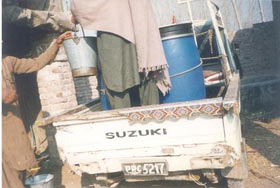 Establishment of farmers organizations at village, district,
provincial and national level will be encouraged and linked with
International Dairy Federation. Genuine problems of dairy farmers
will be discussed, analyzed and solved at proper and competent
fora. Advice will be given to government and development agencies
for improving the farming system and establishment of dairy and
allied industries and technologies. Establishment of farmers organizations at village, district,
provincial and national level will be encouraged and linked with
International Dairy Federation. Genuine problems of dairy farmers
will be discussed, analyzed and solved at proper and competent
fora. Advice will be given to government and development agencies
for improving the farming system and establishment of dairy and
allied industries and technologies.
The project is likely to increase productivity and profitability of
livestock farmers and encourage further investment in the sector,
making the country self-sufficient and capable of exporting dairy
products.
(Muhammad Subhan Qureshi, PhD)
Principal Investigator, AI-PARC
Veterinary Research Institute
PO Box 367, Peshawar 25000, Pakistan.
Tel. Office: +92-91-9210218, Home: 275572, Fax 9210249
E.mail drmsqureshi@yahoo.com
Website
www.geocities.com/drmsqureshi/CV.html
|
Pakissan.com;
|